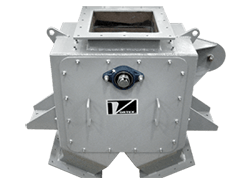Vortex Pivoting Chute Diverter Handles Especially Abrasive Materials
Vortex introduces the Titan Series Pivoting Chute Diverter designed for applications where handling can pose excessive abrasion or wear issues, situations that call for extremely large valves or diverters, conditions that require a valve for especially harsh environments, or other more specialized heavy-duty applications. The Pivoting Chute Diverter is designed to improve processing speeds and provide longevity when handling materials such as alumina, bauxite, cement, clinker, coal, fly ash, gravel and rock, glass, industrial sand, lime, limestone, metals and ores, potash, sands and wood.
Features of the Pivoting Chute Diverter include:
• A body constructed from carbon steel.
• An independent, internal pivoting chute.
• Chute’s wetted parts (ie: material contact areas) are lined with choice of abrasion-resistant metal.
• Optional abrasion-resistant liners installed internally on the chute’s inlet and outlet legs to provide additional durability.
• Dust-tight to atmosphere.
• The Pivoting Chute Diverter may be shifted “on the fly” while materials continue to flow, allowing a non-interrupted material flow. This is reportedly an improvement upon traditional flapper-style diverters, which recommend material flow be shut off prior to shifting the blade.
• Inspection, maintenance or repairs may be quickly and easily performed while the diverter remains in-line from an access panel on the front of the diverter.
• Removable chute, in case it must be inspected, repaired or replaced. Removal is done using lifting lugs and chute-assist rods.
• A replaceable flow control bar mounted between the outlet legs to prevent material from migrating to the opposite leg.
• Material flow may be directed partially toward two different destinations at once.
• Available in either a two-way or three-way configuration.





